The reverse-grip bench press is a variation of the traditional bench press that is performed with a supinated grip (palms facing you, or “underhand”) rather than the standard pronated grip (palms facing away, or “overhand”).
It is a compound exercise that simultaneously works for multiple muscle groups. In addition to targeting the chest, reverse grip bench presses train the triceps, anterior deltoids, and serratus anterior.
Research demonstrates that simply changing from a pronated (overhand) to a supinated (underhand) grip increases upper pectoralis major (clavicular head) activation by approximately 30%: a dramatic improvement over the traditional bench press.
A reverse grip hits the tricep muscles more than the regular bench press. One study has shown that it is one of the best exercise modifications for the standard bench press to prevent and train around shoulder pain.
Supinated grips cause a more tucked-in elbow and change humeral rotation, frequently reducing strain on the anterior shoulder joint. This isn’t universal, but many find it more comfortable.
Want to take your gains to the next level? Discover your daily calorie needs with our free TDEE calculator
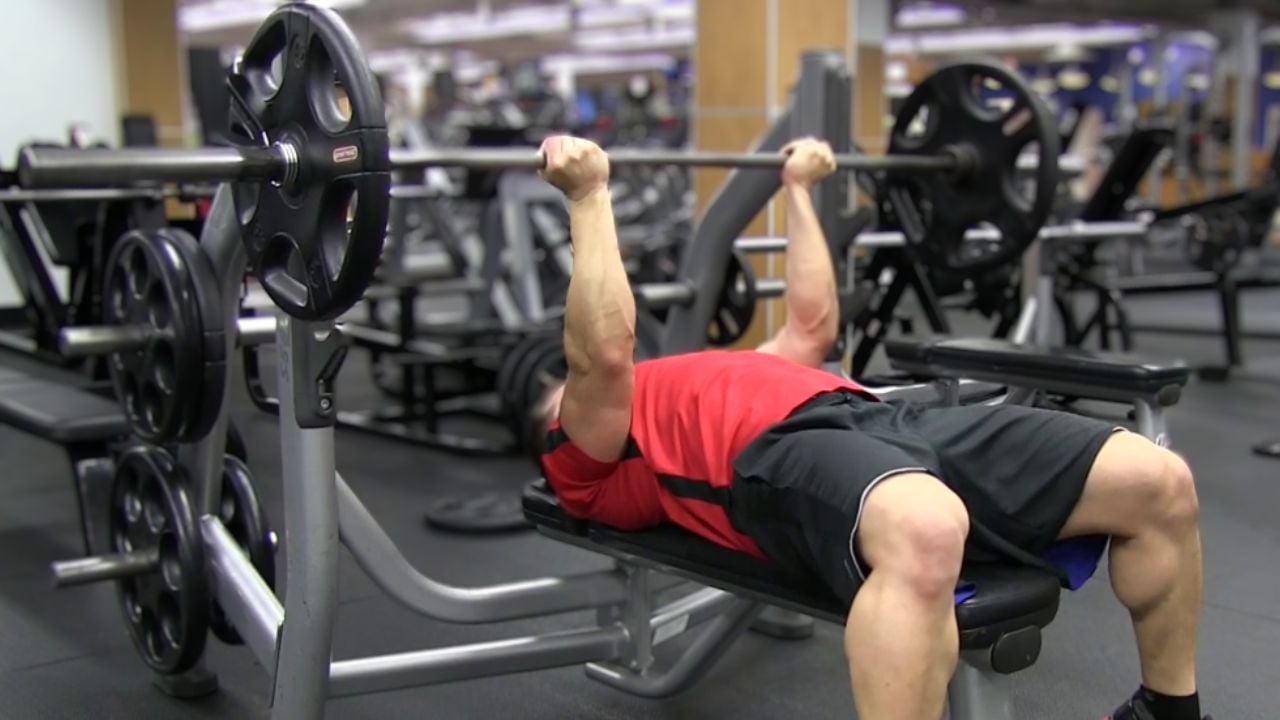
- Reverse Grip Bench Press Muscles Worked
- How To Do Reverse Grip Barbell Bench Press
- Tips For Properly Form
- Sets And Reps
- Best Variations Of Reverse Grip Chest Press
- 1. Incline Reverse Grip Bench Press
- 2. Smith Machine Reverse-Grip Bench Press
- FAQ’s
- Is the reverse grip bench press safe?
- How much weight should I use compared to my regular bench press?
- Reference
Reverse Grip Bench Press Muscles Worked
- Primary Muscles: Pectoralis Major (Mainly Upper Chest), Triceps Brachii and Front deltoids (front shoulders).
- Secondary Muscles: Medial Deltoids and Posterior Deltoids
- Stabilizing Muscles: Bicep brachii, Serratus Anterior, Rhomboids, Middle and Lower Trapezius, Core Musculature and Latissimus Dorsi
A study has shown that a supinated or underhand grip increases activity for the biceps brachii and the pectoralis major’s clavicular portion (Upper chest).
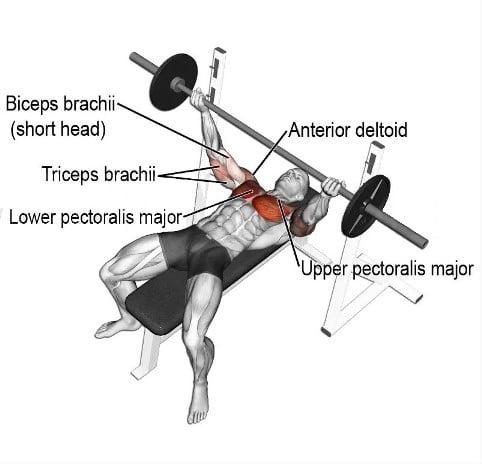
How To Do Reverse Grip Barbell Bench Press
- Lie on a flat bench as you would for a standard bench press. Feet flat on the floor, glutes on the bench, shoulder blades retracted and depressed.
- Position yourself so your eyes are roughly under the bar.
- Reach up and take a supinated (underhand) grip on the barbell.
- Grip width should generally be shoulder-width or slightly narrower. Too wide can put undue stress on the wrists and biceps, and too narrow can limit range of motion. Experiment to find what’s comfortable and practical for you.
- Ensure your wrists are as straight as possible or slightly extended.
- Lower the bar slowly and controllably towards your lower sternum or upper abdomen.
- Keep your elbows tucked relatively close to your sides. Think about pulling the bar down with your lats. Avoid flaring your elbows out. The bar path will naturally be a slight arc.
- Once the bar lightly touches your torso (or reaches your comfortable depth), drive it back up powerfully. Focus on extending your elbows and squeezing your triceps and chest.
Tips For Properly Form
- Keep elbows at approximately a 45° angle from the torso, not tucked too close or flared too wide.
- The reverse grip bench press can be less stable than the regular one. The movement feels very different at first, so start with lighter weights.
- Ensure the grip is tight and the wrists are straight. Avoid letting your wrists flex forward (palms bending towards forearms) or hyperextend excessively (bending too far back) under the load.
- To optimise chest engagement, maintain “shoulders back and down” (retracted and depressed scapulae) throughout the movement.
- Maintain a natural arch in your lower back, but don’t exaggerate it. A slight arch is normal, but your glutes and shoulder blades must remain on the bench.
- Do a full range of motion. Lower the barbell until it is close to your chest. Press it back up to full arm extension without locking out the elbows.
- To maximise muscle growth, do the 8-15 repetition range with moderate loads (65-80% of reverse grip max).
- Always use a spotter when performing the reverse grip bench press, as the grip is less secure than the traditional bench press.
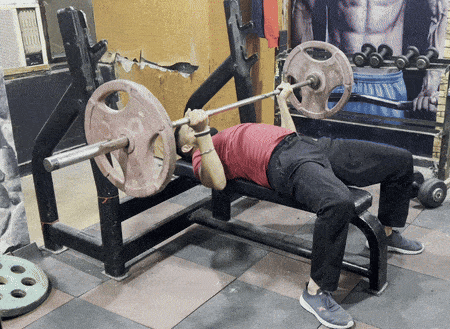
Sets And Reps
The number of sets per week is based on your fitness level. The number of sets per week for a beginner is less than that for an advanced.
- Use a moderately heavy weight for muscle building (Hypertrophy) and do 8–12 reps.
- For strength building, choose a heavier weight and do 3-5 reps that make the last rep of each set very challenging.
- Choose a light to moderate weight for endurance training that can do 15–20 reps.
Best Variations Of Reverse Grip Chest Press
The wide-grip barbell press can be done in different ways to suit your fitness level and your choice.
1. Incline Reverse Grip Bench Press
The incline reverse grip bench press is a variation of the incline barbell press. In this variation, the bench is positioned at an incline of 30–45 degrees, and the barbell is held at a distance greater than shoulder width apart.
Combining the supine grip with the inclined angle stresses the upper chest muscles (front shoulders, triceps) even more than the traditional bench press.
The inclined torso angle is particularly advantageous for lifters who experience shoulder impingement issues during flat bench variations, as it facilitates the natural opening of the shoulder joint for pressing.
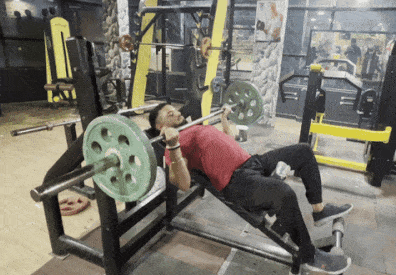
2. Smith Machine Reverse-Grip Bench Press
The Smith Machine Bench Press is a popular gym exercise that helps you lift heavier weights without a spotter. It provides a safer, more controlled environment for performing a technically challenging movement.
Because the Smith machine moves the bar along a fixed vertical (or slightly angled) path, your stabiliser muscles don’t have to work as hard to balance the bar.
Decreasing the demand for stabilisation muscle, you focus on the primary muscles, specifically the triceps and upper pectorals. This can benefit hypertrophy if you’re trying to isolate and fatigue these muscles.
It can be helpful for new people to exercise or want to lift heavier weights.
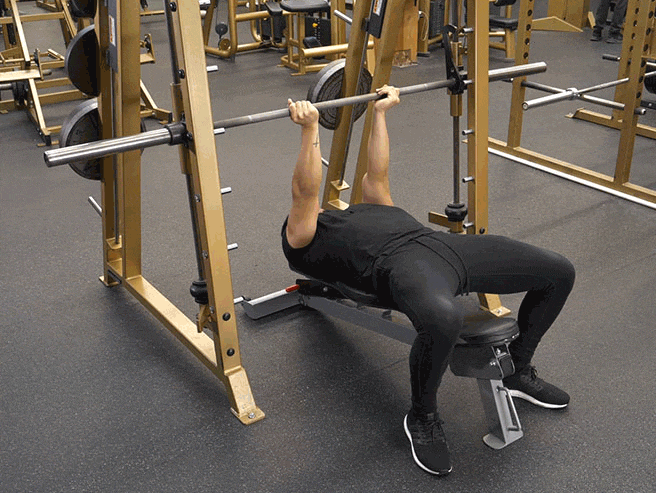
FAQ’s
Is the reverse grip bench press safe?
Yes, when performed with proper technique. The reduced stability of the grip makes using a spotter or safety pins essential. Start with lighter weights to master the movement pattern before progressing to heavier loads.
How much weight should I use compared to my regular bench press?
When first switching to a reverse grip, most lifters should expect to use 70-80% of their traditional bench press weight. This percentage will improve with practice as neural adaptation occurs.
Do you have any questions or tips about the reverse grip barbell press? Please share them in the comments below!
Don’t forget to subscribe to our blog for additional workout guides and valuable information.
Reference
- Guillermo Escalante: Exercise Modification Strategies to Prevent and Train Around Shoulder Pain: Strength & Conditioning Journal 39(3):1 (December 2016). DOI: 10.1519/SSC.0000000000000259.
- Saeterbakken, Atle Hole, et al. “The Effects of Bench Press Variations in Competitive Athletes on Muscle Activity and Performance.” Journal of Human Kinetics, vol. 57, no. 1, 2017, pp. 61–71.
- Lehman, Gregory. (2005). The Influence of Grip Width and Forearm Pronation/Supination on Upper-Body Myoelectric Activity During the Flat Bench Press. Journal of strength and conditioning research / National Strength & Conditioning Association. 19. 587-91. 10.1519/R-15024.1.
- Wattanaprakornkul, Duangjai, et al. “Direction-Specific Recruitment of Rotator Cuff Muscles during Bench Press and Row.” Journal of Electromyography and Kinesiology, vol. 21, no. 6, 2011, pp. 1041–1049.

Manish is a NASM-certified fitness and nutrition coach with over 10 years of experience in weight lifting and fat loss fitness coaching. He specializes in gym-based training and has a lot of knowledge about exercise, lifting technique, biomechanics, and more.
Through “Fit Life Regime,” he generously shares the insights he’s gained over a decade in the field. His goal is to equip others with the knowledge to start their own fitness journey.
